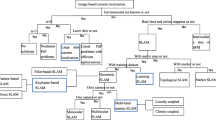Abstract
With the rapid proliferation of video cameras in public places, the ability to identify and track people and other objects creates tremendous opportunities for business and security applications. This paper presents the Multiple Camera Indoor Surveillance project which is devoted to using multiple cameras, agent-based technology and knowledge-based techniques to identify and track people and summarize their activities. We also describe a people localization system, which identifies and localizes people in an indoor environment. The system uses low-level color features – a color histogram and average vertical color – for building people models and the Bayesian decision-making approach for people localization. The results of a pilot experiment that used 32 h of data (4 days × 8 h) showed the average recall and precision values of 68 and 59% respectively. Augmenting the system with domain knowledge, such as location of working places in cubicles, doors and passages, increased the average recall to 87% and precision to 73%.
Similar content being viewed by others
References
Cai Q, Aggarwal JK (1996) Tracking human motion using multiple cameras. In: Proceedings of the international conference on pattern recognition, Vienna, Austria, pp 68–72
Cai Q, Aggarwal JK (1999) Tracking human motion in structured environments using a distributed-camera system. IEEE Transactions on Pattern Analysis and Machine Intelligence 2(11):1241–1247
Fuentes LM, Velastin SA (2001) People tracking in surveillance applications. In: Proceedings of the 2nd IEEE international workshop on PETS, Kauai, Hawaii, USA
Javed O, Rasheed Z, Atalas O, Shah M (2003) KnightM: a real time Surveillance system for multiple overlapping and non-overlapping cameras. The fourth IEEE international conference on multimedia and expo (ICME 2003) Baltimore, MD
Kettnaker V, Zabih R (1999) Bayesian multi-camera surveillance. In: Proceedings of the IEEE conference on computer vision and pattern recognition, Fort Collins, Colorado, pp 2253–2259
Khan S, Javed O, Rasheed Z, Shah M (2001) Human tracking in multiple cameras. In: Proceedings of the 8th IEEE international conference on computer vision, vol 1, Vancouver, Canada, pp 331–336
Krumm J, Harris S, Meyers B, Brumitt B, Hale M, Shafer S (2000) Multi-camera multi-person tracking for easy living. In: Proceedings of the 3rd IEEE international workshop on visual surveillance, Dublin, Ireland
Siebel NT, Maybank S (2002) Fusion of multiple tracking algorithms for robust people tracking. In: Proceedings of the 7th European conference on computer vision (ECCV 2002), vol. IV, Copenhagen, Denmark, pp 373–387
Author information
Authors and Affiliations
Corresponding author
Additional information
Valery A. Petrushin is a senior researcher at the Accenture Technology Labs in Chicago, Illinois USA. He received his M.Sc. in Applied Mathematics from the Kharkov State University, Kharkov, Ukraine, and his Ph.D. in Computer Science from Glushkov Institute for Cybernetics, Kiev, Ukraine. He worked as a Director of Intelligent Tutoring Systems at Glushkov Institute for Cybernetics, Ukraine and a researcher at EduTech Institute at the Georgia Tech, GA, USA. His research interests include multimedia data mining, processing, annotation and retrieval. He is the author of two books and more than 130 publications in the fields of computer science, computer-based education, data mining and signal processing.
Gang Wei received his Ph.D. in Computer Science at Wayne State University, Detroit, Michigan, in May 2001. After that, he joined the Accenture Technology Labs in Chicago, Illinois, USA. He also worked as a summer intern research staff at Phillips Research Labs in New York State in year 1999 and 2000. His research focuses on multimedia annotation and retrieval, image and video processing, and sensor intelligence. He has published two book chapters, and over 20 papers in this area.
Anatole V. Gershman is the global director of technology research for Accenture Technology Labs. He received his Ph.D. degree in Computer Science from Yale University in 1979. He worked at Bell Labs, the Schlumberger Research Centre in Connecticut, Cognitive Systems Inc., and Coopers & Lybrand before he joined Accenture (Andersen Consulting) in 1989. His research interests are in the fields of artificial intelligence, intelligent sensor networks and ubiquitous computing.
Rights and permissions
About this article
Cite this article
Petrushin, V.A., Wei, G. & Gershman, A.V. Multiple-camera people localization in an indoor environment. Knowl Inf Syst 10, 229–241 (2006). https://doi.org/10.1007/s10115-006-0025-7
Received:
Revised:
Accepted:
Published:
Issue Date:
DOI: https://doi.org/10.1007/s10115-006-0025-7




